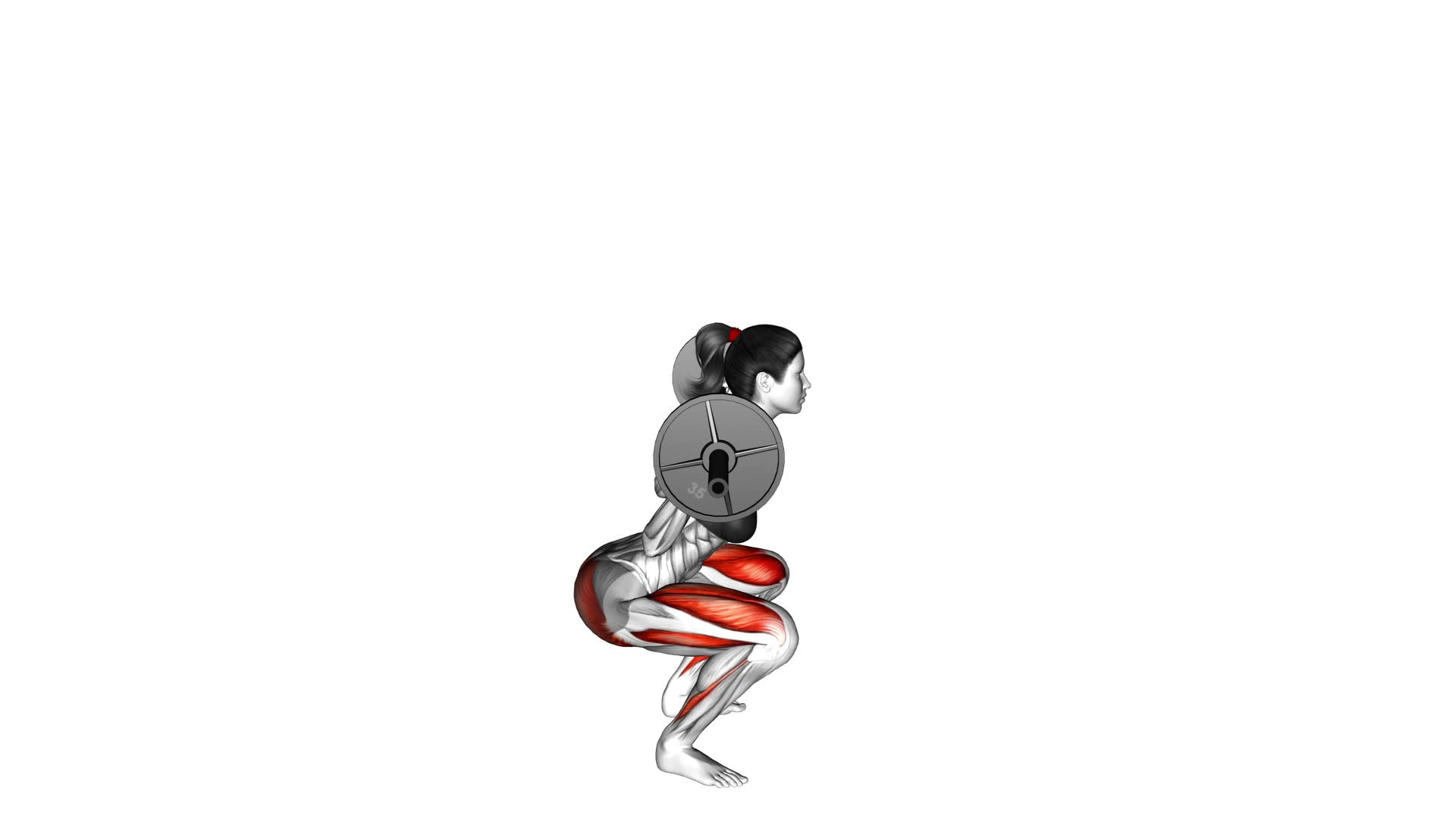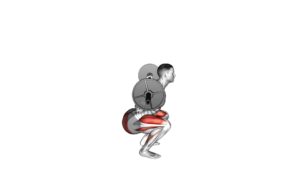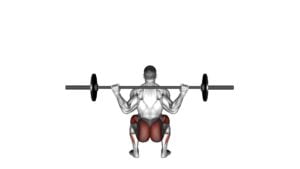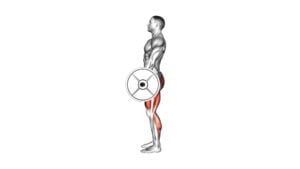Barbell Full Squat (Side POV) (female) – Video Exercise Guide & Tips

In this video exercise guide, you'll learn all about the barbell full squat from a side point of view, specifically tailored for females. Discover the benefits of this powerful exercise, as well as the proper form and technique to maximize your results.
Watch This Exercise Video
We'll also cover common mistakes to avoid, modifications for beginners, and tips for increasing weight and intensity. Plus, we'll provide safety precautions and warm-up exercises to ensure a safe and effective workout.
Let's get started!
Key Takeaways
- Barbell full squat provides significant strength gains and builds lower body strength.
- Proper form and technique, such as maintaining hip and knee alignment, engaging the core, and focusing on breathing, are essential for performing the exercise correctly.
- Common mistakes to avoid include incorrect foot placement, lack of core engagement, and straining the knees.
- Foot placement should be shoulder-width apart with toes slightly outward, and depth control should ensure hips go below parallel to knees while maintaining a neutral spine and engaging the core.
Benefits of Barbell Full Squat
You will experience significant strength gains by incorporating barbell full squats into your workout routine. Not only will it help you build lower body strength, but it will also improve your posture. Barbell full squats engage multiple muscle groups in your lower body, including your quadriceps, hamstrings, glutes, and calves. By performing this exercise regularly, you can expect to see improvements in muscle size and definition in these areas.
One of the key benefits of barbell full squats is their ability to improve your posture. When you perform this exercise correctly, you're required to maintain an upright position with your chest lifted and shoulders back. This helps to strengthen the muscles in your back and core, which are essential for maintaining good posture throughout the day. Additionally, barbell full squats can also help to strengthen the muscles in your hips, which can further contribute to better posture.
In terms of building lower body strength, barbell full squats are one of the most effective exercises you can do. They target your quadriceps, hamstrings, and glutes, which are the largest muscle groups in your lower body. By consistently challenging these muscles with heavy weights, you'll stimulate muscle growth and increase overall strength. This can have a positive impact on your athletic performance and daily activities that require lower body strength, such as climbing stairs or lifting heavy objects.
Incorporating barbell full squats into your workout routine can yield significant strength gains while also improving your posture. By targeting your lower body muscles, this exercise helps to build strength and muscle definition in your quadriceps, hamstrings, and glutes. Additionally, the upright position required during the exercise strengthens your back and core, leading to better posture. Whether you're an athlete looking to enhance performance or simply want to improve your overall strength and posture, barbell full squats are a highly effective exercise to include in your routine.
Proper Form and Technique
To perform a proper barbell full squat, it's important to pay attention to the alignment of your hips and knees. Make sure your knees are tracking in line with your toes and your hips are pushed back as you lower into the squat.
Additionally, proper breathing technique is crucial during squats to maintain stability and control. Remember to inhale deeply before descending and exhale forcefully as you push back up.
Hip and Knee Alignment
Achieving proper hip and knee alignment is crucial for maintaining proper form and technique during the barbell full squat exercise. By ensuring that your hips and knees are aligned correctly, you can maximize muscle activation and minimize the risk of injury.
Here are four key tips to help you achieve proper alignment:
- Stand with your feet shoulder-width apart and toes pointed slightly outward.
- As you lower into the squat, focus on pushing your hips back and bending your knees over your toes.
- Keep your knees in line with your toes throughout the movement to avoid any inward or outward deviation.
- Engage your core and maintain a neutral spine position to support proper alignment and stability.
Breathing During Squats
To maintain proper form and technique during squats, it's essential to focus on your breathing. Proper breathing techniques play a crucial role in supporting your performance and preventing injury.
When performing squats, it's important to inhale deeply before initiating the downward movement. As you descend, exhale slowly and steadily, maintaining control throughout the exercise. This controlled exhalation helps stabilize your core and maintain intra-abdominal pressure, allowing for better balance and stability.
Additionally, focusing on your breath helps you stay mindful and in tune with your body's movements, enhancing your overall squatting experience. By prioritizing proper breathing techniques, you can optimize your squat performance and reduce the risk of injury.
Common Mistakes to Avoid
To ensure proper form and technique, it's important to be aware of common mistakes to avoid during a barbell full squat.
One mistake to watch out for is incorrect foot placement, as this can impact your stability and balance.
Additionally, improper depth control, such as not going low enough or going too low, can put unnecessary strain on your knees.
Finally, lack of core engagement is another common error that can lead to poor form and decreased effectiveness of the exercise.
Incorrect Foot Placement
When performing the barbell full squat, ensure proper foot placement to avoid common mistakes. Correct form and foot positioning are crucial for preventing injuries and maximizing the effectiveness of this exercise. Here are four key points to keep in mind:
- Position your feet shoulder-width apart: Place your feet at a comfortable distance, ensuring that they're parallel to each other. This stance provides stability and allows for proper alignment throughout the movement.
- Point your toes slightly outward: To maintain balance and engage the correct muscles, angle your toes outward at about a 15 to 30-degree angle. Be careful not to excessively turn them, as this can strain the knees.
- Distribute weight evenly: As you descend into the squat, make sure your weight is evenly distributed on both feet. This ensures proper balance and prevents any unnecessary strain on one side.
- Keep your heels on the ground: Throughout the squat, maintain contact between your heels and the floor. This helps to engage the posterior chain muscles and promotes stability.
Remember, proper foot placement is essential for executing the barbell full squat correctly and avoiding injuries.
Now, let's move on to the next section about improper depth control.
Improper Depth Control
One common mistake to avoid when performing the barbell full squat isn't achieving proper depth control. Depth control refers to the ability to lower your body to the correct depth during the squat movement. Common depth mistakes include not going low enough or going too low, both of which can compromise the effectiveness and safety of the exercise.
To ensure proper depth control, it's important to focus on a few key tips.
First, aim to lower your hips below the parallel to your knees. This ensures that you're achieving the full range of motion. Additionally, maintain a neutral spine and engage your core to support proper form throughout the movement.
Lastly, avoid bouncing at the bottom of the squat and instead focus on a controlled and smooth movement.
Lack of Core Engagement
Engage your core to maintain proper form and maximize the benefits of the barbell full squat. Lack of core engagement is a common mistake that can hinder your progress and put you at risk of injury. To ensure core stability and effective muscle activation during the exercise, follow these tips:
- Brace your core: Before you begin the squat, consciously tighten your abdominal muscles as if you were preparing to take a punch. This will provide stability and support throughout the movement.
- Maintain proper alignment: Keep your torso upright and avoid leaning forward excessively. This will help distribute the load evenly and prevent excessive strain on your lower back.
- Breathe correctly: Inhale deeply before descending into the squat, and exhale forcefully as you push back up. This breathing technique will help engage your core muscles and provide additional stability.
- Gradually increase the weight: Start with lighter weights and gradually progress to heavier loads. This will give your core muscles time to adapt and strengthen, ensuring better overall stability during the exercise.
Modifications for Beginners
To make the Barbell Full Squat more accessible for beginners, you can start by using lighter weights or even just your body weight. This modification allows you to focus on mastering the correct form and technique before adding additional resistance. When starting with lighter weights, you can gradually increase the load as you gain confidence and strength.
Beginners often make common errors when performing the Barbell Full Squat. One common mistake is allowing the knees to cave inward during the descent. To avoid this, focus on pushing your knees outwards throughout the movement.
Another common error isn't going low enough in the squat. It's important to aim for a full range of motion, where your thighs are parallel to the ground or even below. This engages the muscles more effectively and ensures proper activation of the glutes, quads, and hamstrings.
Remember to maintain a neutral spine throughout the exercise and keep your core engaged. This will help protect your lower back and improve overall stability. Additionally, it's crucial to breathe properly during the squat. Inhale deeply before descending and exhale forcefully as you push back up.
Tips for Increasing Weight and Intensity
To increase weight and intensity during the Barbell Full Squat, gradually add more resistance to challenge your muscles and improve strength. Here are some tips for increasing resistance and incorporating advanced variations into your workout routine:
- Increase weight: Start by adding small increments of weight to the barbell. As you become more comfortable and confident, gradually increase the weight to continue challenging your muscles.
- Use resistance bands: Incorporate resistance bands into your squat routine to add extra resistance. Attach the bands to the barbell or to your hips for an added challenge during the exercise.
- Try pause squats: Instead of performing the squat in a continuous motion, pause for a few seconds at the bottom of the movement. This will increase the time under tension and intensify the exercise.
- Explore single-leg variations: Once you have mastered the barbell full squat, try advanced variations such as Bulgarian split squats or pistol squats. These exercises require more stability and strength, making them excellent options for increasing intensity.
By gradually increasing resistance and incorporating advanced variations, you can continue challenging your muscles and making progress in your strength training.
Now let's move on to the next section, where we'll discuss safety precautions and warm-up exercises to ensure a safe and effective workout.
Safety Precautions and Warm-up Exercises
Before starting the Barbell Full Squat, it's important to prioritize your safety and properly warm up your muscles. Warm-up routines are crucial to injury prevention and can help prepare your body for the intense workout ahead.
When it comes to warming up, aim to increase your heart rate, activate your muscles, and improve your range of motion. Begin with five to ten minutes of light cardio exercises such as jogging, jumping jacks, or cycling to get your blood flowing and increase your body temperature.
Next, incorporate dynamic stretches that target the muscles you'll be using during the Barbell Full Squat, such as leg swings, hip circles, and lunges. These exercises help to loosen up your joints and improve flexibility.
Additionally, consider performing some bodyweight squats or using a lighter weight to practice the proper form and technique before adding the barbell.
Frequently Asked Questions
What Are the Potential Risks or Injuries Associated With Performing the Barbell Full Squat?
When performing the barbell full squat, there are potential risks or injuries you should be aware of. These include strain on the lower back, knees, and hips, as well as the risk of falling if not done with proper form.
To mitigate these risks, it's important to start with lighter weights and gradually increase. Additionally, consider alternative exercises such as goblet squats or lunges to work the same muscles while reducing the strain on your joints.
Are There Any Alternative Exercises That Can Be Done Instead of the Barbell Full Squat?
Looking for alternative exercises to the barbell full squat?
There are plenty of options that can give you similar benefits.
Try the goblet squat, which uses a dumbbell or kettlebell held at your chest.
You can also do lunges or step-ups to target your legs and glutes.
These exercises provide modifications and variations to suit your needs and goals.
Don't worry, you'll still enjoy the benefits of a great lower body workout.
How Many Sets and Repetitions Should Be Performed When Incorporating the Barbell Full Squat Into a Workout Routine?
When incorporating the barbell full squat into your workout routine, it's important to consider the number of sets and repetitions.
The ideal set and rep range for this exercise is typically 3-4 sets of 8-12 repetitions.
However, you can adjust the number of sets and reps based on your fitness level and goals.
Remember to start with a weight that challenges you but allows for proper form.
As always, consult with a fitness professional for variations and modifications that suit your needs.
Can the Barbell Full Squat Help With Weight Loss or Toning Specific Muscle Groups?
The barbell full squat can definitely help with weight loss and toning specific muscle groups. By incorporating this exercise into your workout routine, you can burn calories and build strength at the same time.
The barbell full squat benefits include targeting multiple muscle groups such as the quadriceps, hamstrings, glutes, and core. To maximize results, focus on proper technique, ensuring you squat low enough and maintain proper form throughout the movement.
Is It Necessary to Have a Spotter or Trainer Present When Performing the Barbell Full Squat?
When performing the barbell full squat, it's important to have a spotter or trainer present.
A spotter can provide assistance and ensure your safety in case you struggle with the weight or lose your balance. They can also help you maintain proper form and technique, maximizing the benefits of the exercise.
A trainer can offer guidance, correct any mistakes, and help you progress in your squatting journey. Their presence is crucial for a successful and safe workout.
Conclusion
In conclusion, the barbell full squat is a highly beneficial exercise for females. It helps in building lower body strength and muscle mass. By following proper form and technique, avoiding common mistakes, and gradually increasing weight and intensity, one can maximize the benefits of this exercise.
It's important to prioritize safety by taking necessary precautions and warming up before performing the barbell full squat. Incorporating this exercise into your fitness routine can lead to improved overall strength and fitness.

Author
Years ago, the spark of my life’s passion ignited in my mind the moment I stepped into the local gym for the first time. The inaugural bead of perspiration, the initial endeavor, the very first surge of endorphins, and a sense of pride that washed over me post-workout marked the beginning of my deep-seated interest in strength sports, fitness, and sports nutrition. This very curiosity blossomed rapidly into a profound fascination, propelling me to earn a Master’s degree in Physical Education from the Academy of Physical Education in Krakow, followed by a Sports Manager diploma from the Jagiellonian University. My journey of growth led me to gain more specialized qualifications, such as being a certified personal trainer with a focus on sports dietetics, a lifeguard, and an instructor for wellness and corrective gymnastics. Theoretical knowledge paired seamlessly with practical experience, reinforcing my belief that the transformation of individuals under my guidance was also a reflection of my personal growth. This belief holds true even today. Each day, I strive to push the boundaries and explore new realms. These realms gently elevate me to greater heights. The unique combination of passion for my field and the continuous quest for growth fuels my drive to break new ground.







